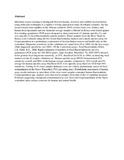Identifying human and livestock sources of fecal contamination in Kenya with host-specific Bacteroidales assays.

View/
Date
2009-11Author
Jenkins MW.
Tiwari S.
Lorente M.
Gichaba Charles M.
Wuertz S.
Type
ArticleLanguage
enMetadata
Show full item recordAbstract
Microbial source tracking to distinguish between human, livestock and wildlife fecal pollution using molecular techniques is a rapidly evolving approach in many developed countries, but has not previously been applied on the African continent. DNA extracts from cow, donkey, and human fecal specimens and raw domestic sewage samples collected in Kenya were tested against five existing quantitative PCR assays designed to detect universal (2), human-specific (2), and cow-specific (1) fecal Bacteroidales genetic markers. Water samples from the River Njoro in Kenya were evaluated using the five tested Bacteroidales markers and a multi-species assay for Cryptosporidium in a preliminary exploration of fecal pollution sources and health risks in this watershed. Diagnostic sensitivity on the validation set varied from 18 to 100% for the five assays while diagnostic specificity was 100%. Of the 2 universal assays, Total Bacteroidales [Dick, L.K, Field, K.G., 2004. Rapid estimation of numbers of fecal Bacteroidetes by use of a quantitative PCR assay for 16S rRNA genes. Appl. Environ. Microbiol. 70, 5695-5697] showed lower generic fecal diagnostic sensitivity, at 55%, than BacUni-UCD, at 100%, in detecting fecal markers on the 42-sample validation set. Human-specific assay HF183 demonstrated 65% sensitivity overall, and 80% on the human sewage samples, compared to 18% overall and 0% sewage for human-specific assay BacHum-UCD. Cow-specific assay BacCow-UCD had 94% sensitivity. Testing of 18 water samples indicates cows are a likely predominant source of fecal contamination in the Njoro Watershed (78% prevailing rate). Probabilistic assessment of human assay results indicates at most three of the river water samples contained human Bacteroidales. Cryptosporidium spp. markers were detected in samples from nine of the 12 sampling locations. Evidence suggesting widespread contamination by cow feces and Cryptosporidium in the Njoro watershed raises serious concerns for human and animal health.
URI
http://www.ncbi.nlm.nih.gov/pubmed/?term=gichaba+c+mhttp://erepository.uonbi.ac.ke:8080/xmlui/handle/123456789/58009
Citation
Water Res. 2009 Nov;43(19):4956-66. doi: 10.1016/j.watres.2009.07.028. Epub 2009 Jul 26.Publisher
University of Nairobi Department of Geology, University of Nairobi
